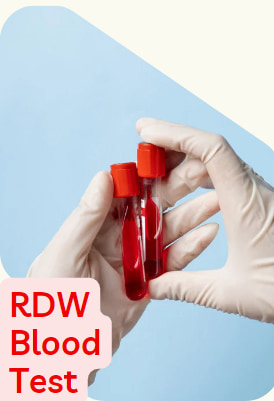Content :
The Red Cell Distribution Width (RDW) test is an important component of a complete blood count (CBC) and is used to measure the variation in the size of red blood cells (RBCs) in a person's bloodstream.
◉ What is RDW blood test?
The RDW blood test is an measure of variation in the size (volume) of red cells in a sample of blood. It is typically obtained through automated hematological analyzers as part of a complete blood count (CBC) panel.
A normal RDW value, typically expressed as a percentage, indicates that cells are generally uniform in size, while a greater than normal RDW suggests greater variation in cell size.
The RDW test is a medical diagnostic tool used in various hematological disorders and diseases, such as anemia, nutritional deficiencies, and even predict the risk of cardiovascular disease.
Even normal results of the RDW test can have clinical significance, and the interpretation should always be done by a healthcare provider in conjunction with other laboratory tests and clinical information."

◉ Why do I need a RDW blood test?
The RDW blood test is commonly included in a complete blood count (CBC), which evaluates different components of the blood.
1- It is usually prescribed as a routine test or as part of the investigation for possible anemia in the presence of the following symptoms:
- Headache.
- Pale or dry skin.
- Weakness in the body.
- Shortness of breath.
- Regular loss of stamina.
- Constant fatigue.
- Dizziness.
2- The RDW blood test is employed in combination with other red blood cell indices to differentiate between various types of anemia, especially to distinguish iron deficiency from thalassemia minor, facilitating precise diagnosis and the choice of appropriate treatment. Some of the RBC indices used alongside RDW include:
- Mean Corpuscular Volume (MCV blood test)
- Mean Corpuscular Hemoglobin (MCH blood test)
- Mean Corpuscular Hemoglobin Concentration (MCHC blood test)
3- The RDW can be used in the laboratory as a flag to select those samples that should have manual review of blood films for red cell morphology.
4- High RDW values have been linked to increased morbidity and mortality in various conditions, including cardiovascular diseases, malignancies, chronic respiratory diseases, metabolic syndrome, chronic kidney disease, and autoimmune disorders.
◉ Taking an RDW Test
◉ Before the RDW Test
Before undergoing any medical test, it's important to consult with a healthcare provider who will determine whether an RDW test is necessary based on your medical history and symptoms.
In general, there are no special preparations to make before the analysis, it is a routine blood test that can be done at any time and does not require fasting, unless your blood sample will be used for further testing.
◉ During the RDW Test
A healthcare provider or phlebotomist will use a needle to draw a small amount of blood from a vein in your arm. They will:
- Clean the area with an antiseptic.
- Insert the needle.
- Collect the blood into a vial.
You may feel a brief sting or pinch when the needle is inserted, but the discomfort is usually minimal.
◉ RDW Normal Level
The normal range for RDW may vary slightly depending on the laboratory and the specific measurement method used. However, in general, the RDW normal range is considered to be between 11.5% and 14.5%.
Note:
- The red cell distribution width is markedly elevated in the newborn period.
- The values are influenced by factors such as erythropoietin levels, age, race, strenuous exercise, and the potential but mixed impact of pregnancy on these values.
- Some forms of anemia or other medical conditions may have a normal RDW result.
◉ High RDW
A high RDW indicates that there is more variation in the size of your red blood cells than what is considered normal. This variation in cell size is known as anisocytosis.
◉ Causes of High RDW
A high RDW blood test may be observed in several types of anemia, including:
- Iron deficiency anemia.
- Anemia caused by vitamin B12 and folate deficiency.
- Sideroblastic Anemia.
- Sickle Cell Anemia.
- Beta thalassemia.
- Drug-induced Anemia
- Hemolytic Anemia.
Other possible causes of high RDW levels may include:
- Heart and Kidney disease
- Acute myeloid leukemia.
- Myelofibrosis.
- Myelodysplastic Syndrome.
- Chronic Liver Disease.
- Chronic Lymphocytic Leukemia (CLL) with High Lymph Count.
- Certain cancer treatments, such as chemotherapy.
◉ Symptoms of High RDW levels
High Red Cell Distribution Width levels themselves do not typically cause symptoms. The symptoms experienced are generally related to the underlying condition or disease causing the elevated RDW.
◉ Normal RDW
RDW within the normal range suggests, in most cases, that the red blood cells in the blood sample are relatively uniform in size, and there is not significant variation in their size.
However, it's essential to remember that certain types of anemia and diseases can be observed with a normal RDW result.
- Thallasemia minor.
- Acute blood loss.
- Chronic liver disease.
- Aplastic anemia.
◉ Additional tests
- Complete Blood Count (CBC): This test measures various blood parameters, including hemoglobin, MCV and MCHC.
- Reticulocyte count.
- Ferritin: Its dosage can help diagnose iron deficiency, a common cause of anemia.
- Vitamin B12 and folic acid: These tests are particularly important in diagnosing megaloblastic anemia.
- Kidney and liver function tests.
◉ Conclusion
The RDW test is a valuable tool in assessing red blood cell size distribution. It can provide important information about various hematological disorders, nutritional deficiencies, chronic diseases, and even predict the risk of cardiovascular disease.
However, it is essential to interpret RDW results in the context of the patient's overall clinical presentation and consider them alongside other laboratory parameters to reach an accurate diagnosis.
Consulting with a healthcare professional is crucial for proper interpretation and understanding of RDW test results.